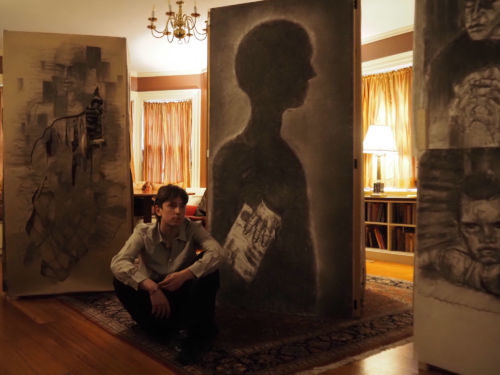When art emerges from the debris of war, it carries memories, lingering with cold uneasiness. On March 29, Nikita Ivaniuta ’28, a first-year student from Ukraine, opened a solo art exhibition at the Signet Society, Harvard’s arts and letters society. Through his work, Ivaniuta reflects on the devastation caused by the ongoing war between Russia and Ukraine, examining how the destruction of architecture erases cultural identity. The dimly lit living room of the Signet Society served as a fitting backdrop for the installation, where Ivaniuta’s team created an ambiance that deepened the seriousness of the exhibition’s themes of memory and liminal space.
Spectators, including Ivaniuta’s friends from Harvard, loved ones from Ukraine, and intrigued art enthusiasts, navigated a narrow path winding around his works. Each artwork, rendered in charcoal and towering eight feet tall, was attached to one side of a four-sided rectangular prism structure. Ivaniuta explained the reasons for this large-scale immersive setup. He intended to evoke an atmosphere of architectural structures similar to Ukraine’s current, war-ridden urban landscape.
“All the pieces are structured as if [they are] buildings and architectural sort of installations,” he shared in an interview with the Independent. The configuration encouraged viewers to trace connections between the related pieces: a progression of scenes that built a cohesive narrative. “It feels like you’re in this sort of, not necessarily warzone, but a place of architecture and urban sort of environment,” Ivaniuta said, underscoring his intent to recreate the unsettling atmosphere through the exhibition’s layout.
Reflecting on how this show differs from previous work he has done, Ivaniuta shared, “It’s become a reflection of self for me because a lot of my work essentially reflects ideas of memory, ideas of how liminal space connects to the idea of memory and how it slows it down.”
Ivaniuta’s aim to define such themes meant depriving his work of color, hence his use of black and white medium. “I don’t want people to be influenced by certain emotions right away and then going, so like seeing a red and then feeling anger, or seeing a blue and feeling some sort of melancholy,” Ivaniuta explained.
Whether bringing forth transitional memories from his home country to coming to the States or illustrating a fragile bridge between war zone destruction and glimpses of civilization, Ivaniuta’s work grapples with the concept of liminal space. Liminal space—explored in many mediums of art—refers to a threshold or transitional space, often evoking feelings of ambiguity and unease.
His pieces were first drawn from personal memories of living in Ukraine before they shifted to more abstract compositions of the ongoing Civil War in Sudan—a conflict he learned about through a close friend from Sudan. By juxtaposing these experiences, Ivaniuta investigates how memory—or lack thereof—shapes the subjective depiction of a warzone he has not witnessed. He represents this through empty spaces and erasure layered over objective renderings in his artwork.
“While I can present the sort of objective reality, or as close to it as possible, of Sudan, I can’t delve deeper into the ideas of memory and what happened in the past,” Ivaniuta explained.
This distinction is evident from some of the artworks in the installations, where pieces representing this specific conflict are more loosely sketched, contrasting with the realistically rendered scenes of the Ukrainian war zone. Intense erasure over previously rendered work defines these empty spaces, evoking unease. The exhibit provides an intriguing reflection on making authentic and palpable art based on people’s lives, whether or not the artist shares their experiences.
When asked how he began having solo art exhibitions, Ivaniuta explained that his journey started with selling his artwork to raise money for charity. As curiosity in his artwork grew with the help of interested buyers who helped him reach out to more prominent names, so did his opportunities. His first solo show took place in high school, where he rented out a space with his school’s support.
“They let me use a big auditorium to help with all the art,” Ivaniuta recalled. “But then the mayor of the town that I presented my first show [in] invited me to close down the theater and then have a solo art show there as well.”
He went on to do three more solo shows before coming to Harvard, one in his hometown, Kyiv, Ukraine; then one in Brussels, Belgium; and a third in London, England.
For such large-scale exhibitions, one might wonder how a Harvard first-year manages to find the space to create and store such massive drawings. Ivaniuta completed all the works for his solo show in the Carpenter Studio, a space designated for Art, Film, and Visual Studies concentrators. He shared that his current introductory AFVS class has been lenient in allowing him to focus on his independent project—this solo show—which he began just a few months ago over winter break.
“It’s the most work I’ve done, I think, probably in my whole career,” Ivaniuta reflected, acknowledging the grueling effort that went into completing the large-scale pieces in such a short time. He also expressed gratitude for the invaluable critiques and feedback from his professor, Rin Johnson, his TF, and PhD classmates, which contributed to the fine-tuning of his show.
“The reason my show changed is because of these critiques,” he shared. Ivaniuta finds that critiques are essential for his future development and ultimately only improve his work as part of the creation process.
Lucie Stefanoni ’27 (luciestefanoni@college.harvard.edu) hopes Ivaniuta is in her next AFVS class.

